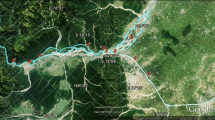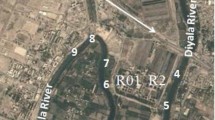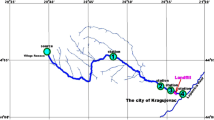Abstract
The present study was conducted on the river Yamuna, which passes through Delhi-NCR from Baghpat to Chhainssa, a distance of about 125 km, at six sampling locations to evaluate the concentrations of heavy metals in surface water using heavy metal pollution index (HPI) approach. The river serves both urban-industrial and rural areas in the study area; hence, domestic, industrial, and agricultural wastes are being contributed greatly in the contamination of river water. The Yamuna River is one of the major tributaries of the river Ganga originated in the Himalayas and is flowing through a varied geological terrain. Metals such as iron (Fe), copper (Cu), cobalt (Co), zinc (Zn), lead (Pb), cyanide (CN), nickel (Ni), and chromium (Cr) in selected sites of Yamuna River water were determined by using atomic absorption spectrophotometer. The concentrations of Fe, Cu, Co, Zn, Pb, CN, Ni, and Cr in the river water were found to be in the range of 40–190, 50–120, 4–66, 840–1800, 2–40, 100–600, 88–253, and 35–52 μg/L, respectively. The results show that the maximum heavy metal content was found at sampling site S3 (Nizamuddin) followed by S6 (Chhainssa), S4 (Okhla), S1 (Baghpat), S5 (Manjhawali), and S2 (Pachahira). The heavy metal data was integrated in GIS environment for preparing spatial distribution maps of sampling sites. A scatter plot matrix was created to assess the pattern and interrelationships between heavy metals. The average concentration of heavy metals was recorded high, often exceeding the permissible limits for drinking of surface water prescribed by the Bureau of Indian Standards (BIS) and World Health Organization (WHO). Based on HPI (varies from 98.2 to 555.1), about 85% of the river water was classified as highly polluted; hence, it is not recommended for drinking. Overall, significant variations were observed in concentrations of heavy metals from one location to the other which may be because of toxic industrial effluents and domestic sewage wastes being added to the river water by various anthropogenic activities in the study area. The present work highlights the pollution load of heavy metals in the river Yamuna and also advocates an urgent attention towards minimizing the health risk of people residing not only along the river banks and surrounding regions but also for city population.






Similar content being viewed by others
References
Abdullah, E. J. (2013). Quality assessment of Shatt Al-Arab River using heavy metal pollution index and metal index. Environmental Earth Sciences, 3, 114–120.
Ahmad, M. K., Islam, S., Rahman, M., Haque, M., & Islam, M. (2010). Heavy metals in water, sediment and some fishes of Buriganga River, Bangladesh. International Journal of Environmental Research, 4, 321–332.
Ajmal, M., Khan, A. M., & Nomani, A. A. (1985). Distribution of heavy metals in water and sediments of selected sites of Yamuna River (India). Environmental Monitoring and Assessment, 5, 205–214.
Alimonti, A., Petrucci, F., Krachler, M., Bocca, B., & Caroli, S. (2000). Reference values for chromium, nickel and vanadiumin urine of youngsters from the urban area of Rome. Journal of Environmental Monitoring, 2, 351–354. https://doi.org/10.1039/B001616K.
APHA. (1998). Standard methods for examination of water and wastewater. Washington: American Public Health Association.
Bhargawa, D. S. (2006). Revival of Mathura’s ailing Yamuna River. Environmentalists, 26, 111–122.
BIS (2012). Drinking water specification. Bureau of Indian Standard, New Delhi IS: 10500.
Census (2011). Primary census abstracts. Registrar General of India, Ministry of Home Affairs, Government of India. Available at: http://www.censusindia.gov.in/2011-common/censusdata2011.html.
CPCB (Central Pollution Control Board) (2006). Water quality status of Yamuna River. Central Pollution Control Board, Government of India.
CPCB (Central Pollution Control Board). (2007). Water quality status of river Yamuna (1999-2005), Assessment and development study of river basin series (ADSORBS). Delhi: Central Pollution Control Board.
CPCB (Central Pollution Control Board) (2008). Status of Water Quality in India – 2007, Central Pollution Control Board, Government of India.
CWC (2011). Water quality “Hot spots” in rivers of India. Central Water Commission, Government of India, New Delhi.
Dalai, T. D., Rengarajan, R., & Patel, P. P. (2004). Sediment geochemistry of the Yamuna River system in the Himalaya: implications to weathering and transport. Geochemical Journal, 38, 441–453.
Datta, C. (1992). Yamuna River turned sewer. Economic and Political Weekly, 27, 2633–2636.
DJB (Delhi Jal Board) (2016). Action Plan for Cleaning the River Yamuna. DelhiJalBorad, Government of NCT Delhi, India.
Dubey, C. S., Mishra, B. K., Shukla, P. D., Singh, R. P., Tajbakhsh, M., & Sakhare, P. (2012). Anthropogenic arsenic menace in Delhi Yamuna flood plains. Environmental Earth Sciences, 65, 131–139.
Florea, A. M., & Busselberg, D. (2006). Occurrence, use and potential toxic effect of metals and metal compounds. Biometals, 19, 419–427. https://doi.org/10.1007/s10534-005-4451-x.
Giri, S., & Singh, A. K. (2014). Assessment of surface water quality using heavy metal pollution index in Subernarekha River, India. Water Quality Exposure and Health, 5, 173–182.
Huang, Y., Chen, Q., Deng, M., Japenga, J., Li, T., Yang, X., & He, Z. (2018). Heavy metal pollution and health risk assessment of agricultural soils in a typical peri-urban area in southeast China. Journal of Environmental Management, 207, 159–168.
Jain, S. K., Agarwal, P. K., & Singh, V. P. (2007). Hydrology and water resources of India. Water science and technology library (Vol. 57). Dordrecht: Springer.
Jaishankar, M., Tseten, T., Anbalgan, N., Mathew, B. B., & Beeregowda, K. N. (2014). Toxicity, mechanism and health effects of some heavy metals. Interdisciplinary Toxicology, 7, 60–72.
Kansal, A., Siddiqui, N. A., & Gautam, A. (2013). Assessment of heavy metals and their interrelationships with some physicochemical parameters in eco-efficient of Himalayan region. Environmental Monitoring and Assessment, 185, 2553–2563. https://doi.org/10.1007/s10661-012-2730-x.
Kaufmann, R. B., Staes, C. J., & Matte, T. D. (2003). Death related to lead poisoning in the United States, 1979 – 1998. Environmental Research, 91, 78–84.
Krishan, G., Singh, S., Sharma, A., Sandhu, C., Kumar, S., Kumar, C. P., & Gurjar, S. (2017). Assessment of river and groundwater interaction using isotopes in Agra and Mathura area of Uttar Pradesh, India. International Journal of Hydrology, 1(3), 1–4.
Kumar, M., & Puri, A. (2012). A review of permissible limits of drinking water. Indian Journal of Occupational and Environmental Medicine, 16, 40–44.
Kumar, M., Sharif, M., & Ahmed, S. (2019). Impact of urbanization on the river Yamuna Basin. International Journal of River Basin Management, 18, 461–475. https://doi.org/10.1080/15715124.2019.1613412.
Lewis, H. (2007). Hindon River: Gasping for breath. A paper on river pollution. Janhit Foundation.
Mehra, A., Farago, M. E., & Banergee, D. K. (2000). A study of Eichhornia crassipes growing in the overbank and floodplains soils of the River Yamuna in Delhi. Environmental Monitoring and Assessment, 60, 25–45.
Mohan, S. V., Nithila, P., & Reddy, S. J. (1996). Estimation of heavy metals in drinking water and development of heavy metal pollution index. Journal of Environmental Science and Health, A31, 283–289.
Muthaiyah, N. P. (2020). Rejuvenating Yamuna River by wastewater treatment and management. International Journal of Energy and Environmental Science, 5(1), 14–29.
Paul, D. (2017). Research on heavy metal pollution of river Ganga: A review. Annals of Agrarian Science, 15, 278–286.
Prasad, B., & Bose, J. M. (2001). Evaluation of heavy metal pollution index for surface and spring water near a limestone mining area of lower Himalayas. Environmental Geology, 41, 186–188.
Prasad, S., Saluja, R., Joshi, V., & Garg, K. J. (2020). Heavy metal pollution of the Upper Ganga River, India: Human health risk assessment. Environmental Monitoring and Assessment, 192, 742.
Rao, K. N., & Latha, P. S. (2019). Groundwater quality assessment using water quality index with a special focus on vulnerable tribal region of Western Ghats hard rock terrain Southern India. Arabian Journal of Geosciences, 12, 267.
Sekibera, K., Origa, H. O., Basamba, A. T., Mutumba, G., & Kakudid, E. (2010). Assessment of heavy metal pollution in the urban stream sediments and its tributaries. International Journal of Environmental Science and Technology, 7(3), 435–446.
Sharma, D., Gupta, R., Singh, R. K., & Kansal, A. (2011). Characteristics of the event mean concentration (EMCs) from rainfall runoff on mixed agricultural land use in the shoreline zone of the Yamuna River in Delhi, India. Applied Water Science, 2, 55–62.
Sharma, D., Kansal, A., & Pelletier, G. (2017). Water quality modeling for urban reach of Yamuna River, India (1999 - 2009), using QUAL2Kw. Applied Water Science, 7, 1575–1559.
Singh, M. (2001). Heavy metal pollution in freshly deposited sediments of the Yamuna River (the Ganges River tributary): a case study from Delhi and Agra urban centers, India. Environmental Geology, 40, 664–672.
Solenkova, N. V., Newman, J. D., Berger, J. S., Thurston, G., Hochman, J. S., & Lamas, G. A. (2014). Metal pollutants and cardiovascular disease: mechanism and consequences of exposure. American Heart Journal, 168, 812–822.
Tiwari, A. K., Maio, M. D., Singh, P. K., & Mahato, M. K. (2015). Evaluation of surface water quality by using GIS and a heavy metal pollution index (HPI) model in a coal mining area, India. Bulletin of Environmental Contamination and Toxicology, 95, 304–310.
Tomlinson, D. L., Wilson, J. G., Harris, C. R., & Jeffrey, W. (1980). Problems in the assessment of heavy metal levels in estuaries and the formation of pollution index. HelgolanderMeeresuntersuchungen, 33, 566–575.
USEPA (2001). Risk based concentration table. United States Environmental Protection Agency, Washington, DC.
Yang, Y., Chen, F., Zhang, L., Liu, J., Wu, S., & Kang, M. (2012). Comprehensive assessment of heavy metal contamination in sediment of the Pearl River Estuary and adjacent shelf. Marine Pollution Bulletin, 64, 1947–1955.
Zakhem, B. A., & Hafez, R. (2015). Heavy metal pollution index for groundwater quality assessment in Damascus oasis, Syria. Environment and Earth Science, 73, 6591–6600.
Zukowska, J., & Biziuk, M. (2008). Methodological evaluation of method for dietary heavy metal intake. Journal of Food Science, 73, R21–R29.
Acknowledgments
Mohd Asim is grateful to University Grants Commission (UGC), New Delhi, for providing financial assistance in the form of Junior Research Fellowship (JRF) for conducting Ph.D research work. The authors thank Central Laboratory, Delhi Jal Board, Govt. of NCT Delhi, for providing laboratory facilities and also thank the anonymous reviewers for their suggestions in improving the manuscript.
Author information
Authors and Affiliations
Corresponding author
Additional information
Publisher’s note
Springer Nature remains neutral with regard to jurisdictional claims in published maps and institutional affiliations.
Rights and permissions
About this article
Cite this article
Asim, M., Nageswara Rao, K. Assessment of heavy metal pollution in Yamuna River, Delhi-NCR, using heavy metal pollution index and GIS. Environ Monit Assess 193, 103 (2021). https://doi.org/10.1007/s10661-021-08886-6
Received:
Accepted:
Published:
DOI: https://doi.org/10.1007/s10661-021-08886-6




